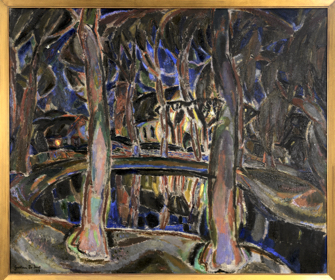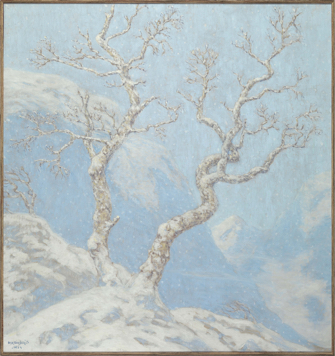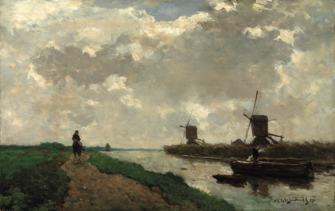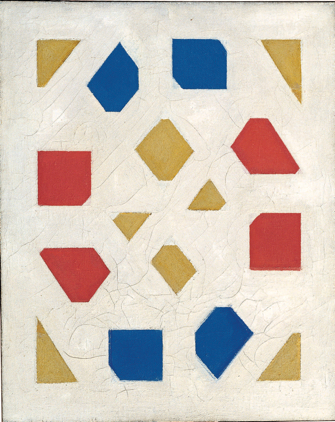Dutch Artists:
Beyond the Golden Age

“Brink in Laren” (1916), by Gustave de Smet. © Adagp, Paris 2016
Troyes is one of the many beautiful small French cities with a wealth of treasures that is often overlooked by visitors. Located smack in the heart of champagne country, the former bishop’s seat has, among many other charms, an imposing Gothic cathedral flanked by the Musée des Beaux Arts and the Musée d’Art Moderne. The latter’s new exhibition, called “Dutch Modernity: The Singer Collection,” features the collection of the Singer Laren Museum in the Netherlands.
The museum in Laren was founded by William Henry Singer, Jr. (1868–1943), scion of the Pittsburgh steel magnate, and his wife Anna Brugh Singer. Much to his father’s dismay, Singer chose to become an artist and moved with his wife to Europe, where he befriended and collected the work of many artists of the day.
In a happy exchange, the Singer Laren Museum has temporarily exchanged its collection with that of the Troyes Modern Art Museum, largely composed of a major donation from Pierre (1907-2002) and Denise Lévy, a local couple whose fortune came from the textile industry. Although the Lévys and the Singers were not from the same generation, they collected works from more or less the same period, 1850-1950, and even some of the same artists, including Kees Van Dongen.
The great interest of this show is its presentation in France of a number of 19th- and early-20th-century Dutch artists whose work is not well known here. During much of that fecund period in the history of European art, France seemed to be the center of all innovation in art, with its influence radiating out to the rest of Europe. While that was also true in the Netherlands, something else was going on in the second half of the 19th century. Artists were finally breaking away from the heavy shadow of the Golden Age, which had dominated painting in the country ever since the 17th century, and were finding their own way to modernity, influenced by the news from the French art world.
The Singers collected French art, some of which is shown here, including a few works by William Henry Jr. himself, who was a competent if not inspired painter, but after

“Camarades” (1924), by William Henry Singer, Jr.
the first room, which also features a striking group of paintings by Henri Le Sidaner (1862-1939) and a few Rodin sculptures, the bulk of the show consists of the work of Dutch artists.
The couple lived in Laren, near Amsterdam, which at the time was a hotspot for Dutch artistic activity. The first two rooms of Dutch works, by artists of the School of Amsterdam and The Hague, are filled with a symphony of brooding skies, as only the Dutch can paint

“Polder Landscape with Windmills” (1890), by Hendrik Johannes Weissenbruch.
them, under which men and women toil on land or by the sea, among them works by the Realist Anton Mauve (Van Gogh’s teacher) and Jozef Israëls, who had studied in Paris.
The generally gray, gloomy look of many of the works is interrupted by the sun-drenched colors of “View of the Village of Blaricum,” painted in 1899 by Co Breman after he returned from a trip to Paris. It caused a positive scandal among Dutch critics, who thought it looked as if it were lit by “horrible electric light.”
Electric color no longer seems so shocking as we move into the 20th century and Expressionism, Fauvism and many other modern “isms” come and go. There are several fine portraits here by Jan Sluijters (1881-1957), notably two of women dressed in red, one a Spanish dancer caught up in swirling movement and the other a dignified woman sitting regally for the painter wearing only a diaphanous red drape. The sitter for the latter, Tonia Stieltjes, was one of the first women from the Dutch colony of Suriname to live in the Netherlands. Her father was a slave, but she ended up becoming a model and moving to Paris, where she had a salon and became friends with Mondrian and other artists. This painting narrowly escaped being destroyed by the Nazi occupiers during World War II.
Piet Mondrian, meanwhile, had been stuck in the Netherlands during World War I and was living in Laren, where he met Bart van der Leck, who was instrumental in influencing

“Composition” (1918), by Bart van der Leck. © Adagp, Paris 2016.
the new direction – pure abstraction and the use of only primary colors – that would make Mondrian famous. The show includes several works by van der Leck, who ended up compromising on his insistence on abstraction to please his clients.
If an excuse is needed to visit the lovely city of Troyes, this fine survey of a hundred years of Dutch art is an excellent one.
Recommended restaurants in Troyes: Aux Crieurs de Vin and Le Champ des Oiseaux.
Musée d’Art Moderne: 14, place Saint-Pierre, 10000 Troyes. Tel.: 03 25 76 26 80. Open Tuesday-Sunday. Closed Monday. Admission: €5. Through August 28, 2016. www.musees-troyes.com
Reader reaction: Click here to respond to this article (your response may be published on this page and is subject to editing).
More reviews of Paris art shows.
© 2016 Paris Update
Favorite